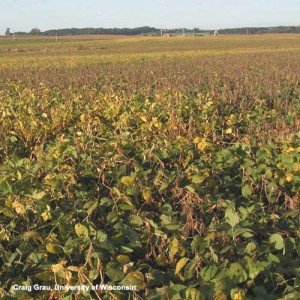Each year, the occurrence of white mold is heavily dependent on weather conditions during soybean flowering and early pod development. Rain, cool temperatures, high relative humidity, and moist soil favor the growth of the fungus if it is present. However, pathogen biology and crop management decisions interact strongly with weather to determine the risk of production losses caused by white mold .
Seasonal risk factors
- Weather: Cool temperatures (below < 85° F), normal or above normal rainfall, soil moisture at field capacity or above, prolonged morning fog and leaf wetness (high canopy humidity) at and following flowering into early pod development.
- Field/cropping history: the amount of the pathogen will gradually increase if other host crops are grown in rotation with soybean, if there are only short intervals between soybean crops and if soybean varieties susceptible to white mold are grown.
- Early canopy closure due to early planting, high plant population, narrow rows, excessive plant nutrition and optimal climatic conditions. A dense canopy increases the numbers of apothecia on the soil surface.
- Weed management: Poor broadleaf weed control favors white mold. Some herbicides used in rotation systems may be suppressive to white mold.
Long term risk factors
- History of white mold: high population density of the white mold pathogen; apothecia present on soil surface at flowering;
- Distribution of the pathogen/disease in the field. The topography of field will influence where white mold occurs. The most conducive areas are pockets of poor air drainage, tree lines and other natural barriers that impede air movement.
- Soybean variety planted: Soybean varieties differ in their reaction to white mold, governed by physiological functions and plant structure of the specific soybean variety.
- Pathogen introduction. Sclerotinia sclerotiorum spreads from field to field in contaminated and infected seed, by the movement of infested soil with equipment , and by windborne spores from apothecia from areas outside fields.
Maintenance of soybean plant health requires that management practices be tailored to specific fields, farm, or region. Reducing the risk of white mold and maximizing soybean yield in the presence of white mold can be achieved on a field-by-field basis by choosing management practices that
- prevent or slow the introduction of the white mold pathogen into a field
- steadily work towards reducing the population of the fungus in the soil
- provides a feasible compromise between lowering white mold potential and maintaining maximum yield potential.



